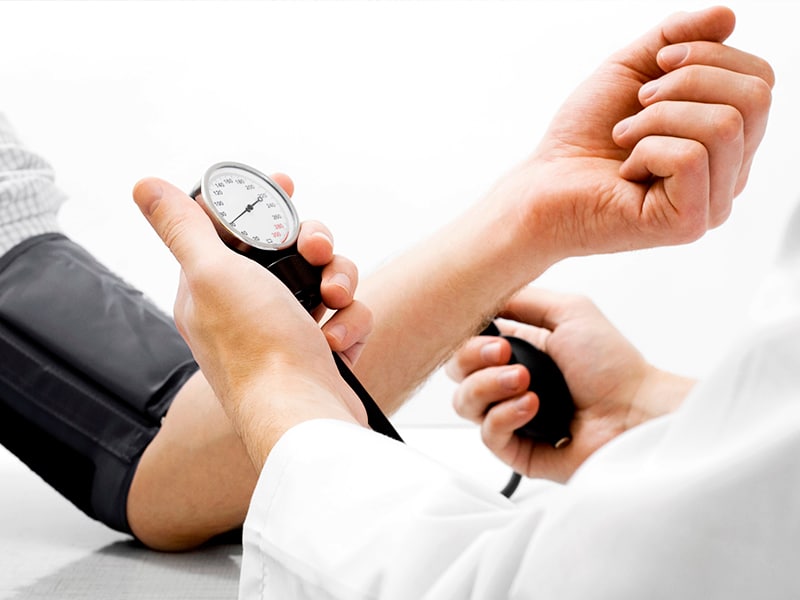Hypertension is the medical term for high blood pressure, a disease known as “a silent killer”. Blood pressure is a measure of the force exerted against the walls of the arteries when the heart pumps blood throughout the body. About 80 million people in the United States, about 33 per cent of the total population. It is believed that 16 million more have no idea they have this disease.
Not treating high blood pressure can lead to multiple medical conditions such as heart disease, stroke, heart attack, kidney failure, eye disorders, and other health problems.
The heart is the main engine of the body and is responsible for pumping blood through a network of arteries, veins and capillaries. Hypertension occurs when the arterioles, small arteries that regulate blood flow, narrow or contract, so the heart has to exert more effort to pump blood through smaller spaces. Inevitably, blood pressure rises.
This condition is widespread because a poor diet, stress and a poor lifestyle worsen blood pressure values. Most people who suffer from it ignore the symptoms until the consequences become severe and the damage irreversible. Hypertension can be prevented and controlled.
When is Blood Pressure ‘High’?
The measurement of blood pressure provides two values, one higher than the other. The highest number is called systolic blood pressure and indicates the pressure in the arteries when the heart beats. The lowest is known as diastolic blood pressure and measures the tension between heart beats. The readings are high when one or both are above average.
Blood pressure is measured in millimeters of mercury (mm Hg). For example, the common and healthier blood pressure level is 120/80 mm Hg. Blood pressure measurements fall into four categories (focused on people who do not take medications for hypertension and are not sick):
- Normal blood pressure: Values are below 120/80 mm Hg in most cases after checking pressure.
- High blood pressure: This category is when the systolic pressure is between 120 and 129 mm Hg and the diastolic pressure is below 80 mm Hg. When this occurs continuously, it tends to get worse over time, so it is vital to control blood pressure.
- First stage of hypertension: When the values are continuously between 130 and 139 mm Hg for systolic pressure and 80 and 89 mm Hg for diastolic.
- Second stage of hypertension: Values in this stage imply greater danger and the condition is regarded as severe. Systolic pressure values are 140 mm Hg or higher and diastolic pressure 90 mm Hg or higher.
Hypertension Risk Factors
Hypertension can be primary, also known as essential, or secondary; in the first case, the cause is usually unknown, but certain factors are thought to that lead to elevation of blood pressure. Primary hypertension occurs in 90-95 per cent of high blood pressure cases, and the risk factors are:
- A family history of hypertension.
- People over 60 years are more likely to have hypertension. Over time, blood vessels weaken and lose elasticity, preventing adequate blood flow and causing pressure to rise more frequently.
- Men tend to suffer more from hypertension. The risk for women increases after 55 years.
- The incidence is higher in African-American people, it occurs at a younger age and the level of severity is higher.
- Being overweight or obesity.
- Tobacco use affects blood vessels.
- Use of oral contraceptives. When combined with smoking, the risk increases.
- High and constant stress levels. According to the results of several studies, the emotions that produce stress such as anger and hostility, contribute to the development of hypertension disease.
- Excessive alcohol consumption.
- Food rich in saturated fats.
- Food rich in sodium (salt).
- Being sedentary.
- Diabetes.
Between 5 per cent and 10 per cent of high blood pressure cases are secondary hypertension caused by another disease, mostly kidney disorders. Other conditions causing a rise in blood pressure include:
- Alteration of the parathyroid glands.
- Acromegaly — when the pituitary gland excessively produces growth hormone.
- Tumors in the adrenal or pituitary gland.
- Pregnancy.
- Reactions to medications.
Hypertension Symptoms and Diagnosis
In most cases, people do not have symptoms, although head and chest palpitations, dizziness and headaches may be warnings of higher peaks of blood pressure. And when there are no warning signs, high blood pressure can go unnoticed for years.
Constant high blood pressure should be treated soon. When high values are present, a doctor will review the medical file and perform routine physical exams such as urinalysis, blood test and cholesterol test to determine factors affecting blood flow. An electrocardiogram to measure electrical activity of the heart, or an echocardiogram to look for signs of heart disease, could be used.
Routinely a doctor uses a sphygmomanometer to measure, at different times, systolic and diastolic blood pressure values to determine the severity of the condition. Doctors also check blood vessels of the eyes with an ophthalmoscope to determine if there has been thickening, narrowing or a rupture, and, of course, they listen to the heart’s sound and the flow of the arteries with a stethoscope. They may also require a chest x-ray.
Blood pressure should be measured over several days. A high reading in the doctor’s office could be due to anxiety and stress and another reading should be taken.
Hypertension Treatment
The first method is to make a change in lifestyle. A healthy diet with minimal salt content, regular exercise, quitting smoking, not drinking alcohol excessively and maintaining a healthy weight will have a significant effect on the control of high blood pressure. However, to control hypertension, it is not always enough to change lifestyle and medication to lower blood pressure will probably be prescribed.
Although the goal is to achieve values less than or equal to 120/80 mm Hg, it is not always necessary to have a treatment to reach these numbers. Values can be:
- Less than 150/90 mm Hg if you are a healthy adult over 60.
- Less than 150/90 mm Hg if you are a healthy adult under 60.
- Less than 140/90 mm Hg if you have chronic kidney disease, diabetes, coronary artery disease or risk of it.
Hypertension Medications
The most common types of medications to treat hypertension are:
- Thiazide diuretics. They act on the kidneys to eliminate sodium and water from the body, reducing the volume of the blood; a side effect of diuretics is the increased need to urinate. This medicine as a treatment for hypertension can be hydrochlorothiazide, chlorthalidone and others.
- Beta blockers. They open the blood vessels so the heart can slow down and work with less effort. Examples of these medications are acebutolol, atenolol and others. Beta blockers must be combined with other medicines to be effective.
- Inhibitors of angiotensin-converting enzyme. Lisinopril, benazepril, captopril and others. These relax the blood vessels by blocking the formation of a natural chemical that narrows them.
- Angiotensin II receptor blockers. This medication relaxes blood vessels and, unlike the previous one, blocks the action, but not the formation, of the chemical substance that narrows them. Medications include candesartan and losartan.
- Calcium channel blockers. They help to relax the muscles of the blood vessels and some decrease the heart rate. These medications include amlodipine and diltiazem.











